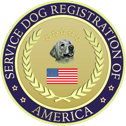Can You Have Other Dogs with a Service Dog?
2023-03-31Yes! In theory, introducing a service dog in your home where there are already other canine pets should be a walk in the park, but the reality? Well, it’s a little more complicated.
Depending on their specific training, a service dog may work more or less all day. This can make it hard for them to interact with a canine pet.
Here’s the good news: while mixing a service dog with another pet may be challenging, it’s not impossible. Find out how below.
Can You Have Non-Service Dogs with a Service Dog?
Service dogs and pets can live together but the success of this arrangement depends upon the specific role the dog is required to perform and their level of training.
The relaxed lifestyle of a canine family pet may cause difficulties with a highly trained working animal that is effectively on alert and doing a job at nearly all times. It sounds like an excellent idea to give them a companion, but it may prove too distracting.
Pets and service dogs can and often do live together. This may require specialized training for the companion animal so that they don’t distract and detract from the role of the working dog. Every situation is unique and requires individual evaluation.
What Are The Differences Between Non-Service and Service Dogs?
A Service Dog Is Not a Pet
A service dog will have a close but different bond with their owner. The relationship is not one of human and pet, although the love and compassion between the owner and their trained canine can be as close as that of a cherished pet.
Different Training and Less Freedom
A service dog is trained to perform a specific role and is classified as a working dog. They could be in their working capacity most of the day within the home environment or only required to support and assist in specific circumstances.
A companion canine may still be obedient and respond to commands, but its training is different. Service dogs’ training links to purpose, while dog training for pets merely instills manners, control, and good behavior.
Most often, pets have much more freedom in their daily lives than a medical alert dog or a guide dog, which is constantly vigilant and working.
Even when a service dog looks relaxed and resting, it’s still on high alert for specific triggers or indicators that it will need to perform a particular function. This can make it difficult for service dogs to interact with family pets at playtime.
Likewise, you may instill some rules for a house pet, such as behavior at feed times and exercise, but generally, they can do what they like when they like. And while service dogs have downtime and rest periods, they are always on the alert as part of their job.
Legal Status
Service dogs have legal status under the Americans with Disabilities Act (ADA). While they must train for their new role, the training doesn’t need to come from a professional. Instead, an owner or handler can train their service dog.
Accessibility
Because service dogs have a separate legal classification, they are awarded access rights and exemptions in certain circumstances.
This means a service dog can go to locations where a house pet can’t, such as a restaurant or a plane cabin. A service dog would be allowed into temporary or permanent accommodations not typically permitted for other animals.
Extra fees cannot be levied as a pet tariff for service dogs – for instance, at hotels where there is usually an additional charge for animals. Under a standard scenario, an owner may have to pay for a pet’s stay – but not a service dog.
How To Keep Your Non-Service and Service Dogs Separated?
A proper routine will help both dogs understand their role and place in the household. Each situation and owner’s needs are unique, so it’s essential to be flexible to reflect specific circumstances.
Depending on the underlying health condition or support required, spending time with the family pet on their own can be easier than trying to mix dogs who will want to play together. This can prove distracting if the trained canine is working.
Some service dogs are not required to be constantly alert; they may mix easily with the family pet at certain times of the day. It’s vital to ensure they don’t acquire bad habits that could detract from their job.
Working out the right level of separation and how to do it depends upon the nature of the service dog’s role and the temperament of both canines. It’s certainly easier with some dogs than others.
Some owners will keep their service dog with them in a working capacity and then kennelled outside when they are not working. This is similar to separating a family pet and a working dog, like a farm or hunting dog.
These dogs may have supervised play together, but their interaction with the family and feeding remains separate – for good reason.
Dogs compete for affection and attention. Suppose the dogs are separated and only mix at certain times. In that case, it’s crucial to do so without stressing them or unintentionally introducing an element of competition.
Professional advice from an experienced dog trainer may prove helpful, as well as solving any problems that have arisen by keeping the dogs apart or allowing them to mix too freely.
Register Your Service Dog with SDRA Today!
At SDRA, we will happily assist with all aspects of looking after and managing a service dog.
Register your service dog with SDRA today and get a vest to help with their identification. It’s much easier for other dog owners to understand your dog’s status and keep them away if they can visually identify them! Got any other questions? Reach out today.
